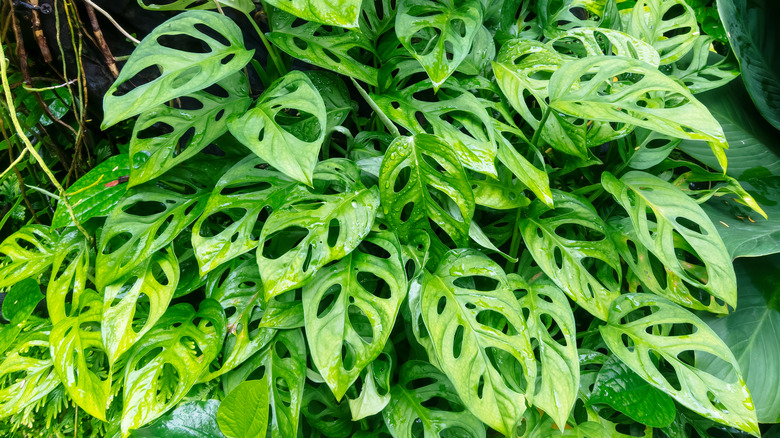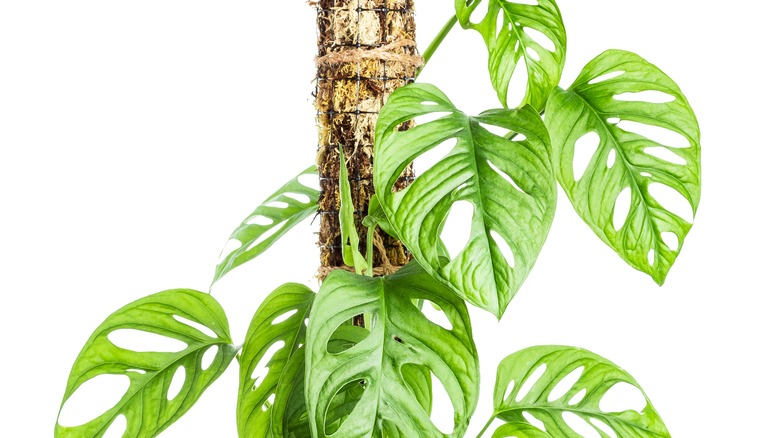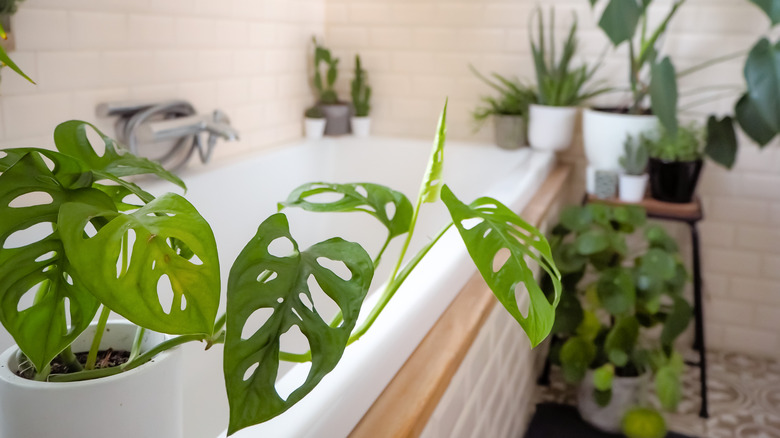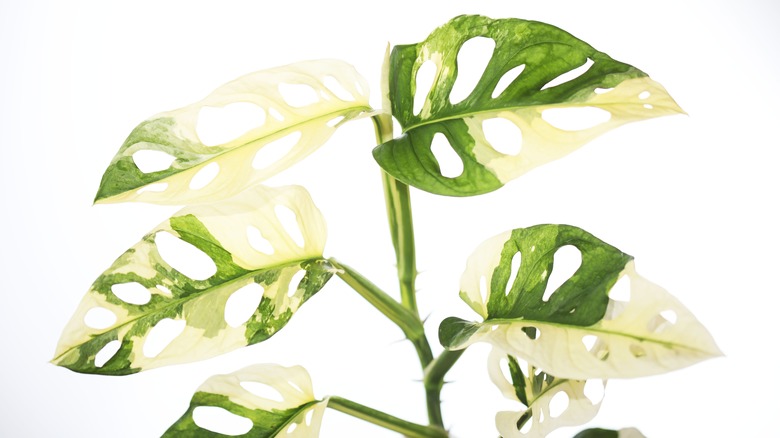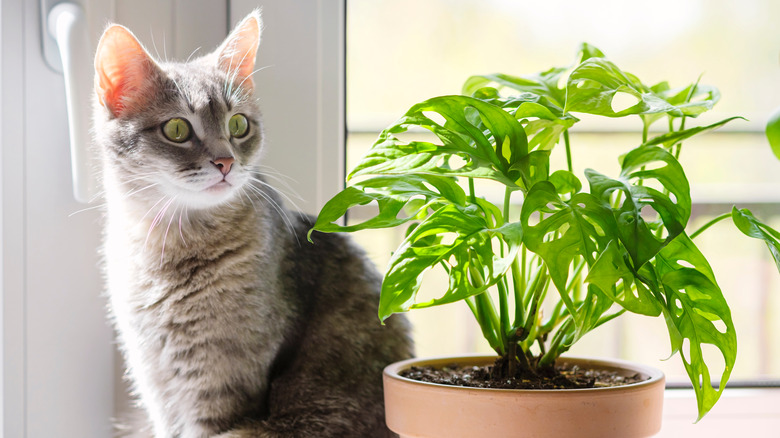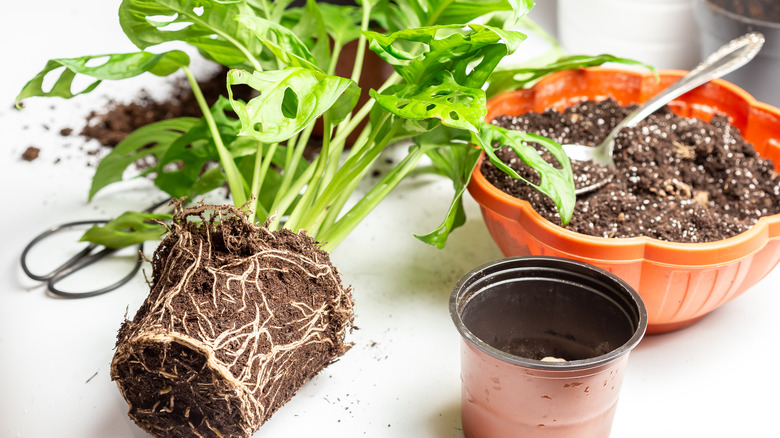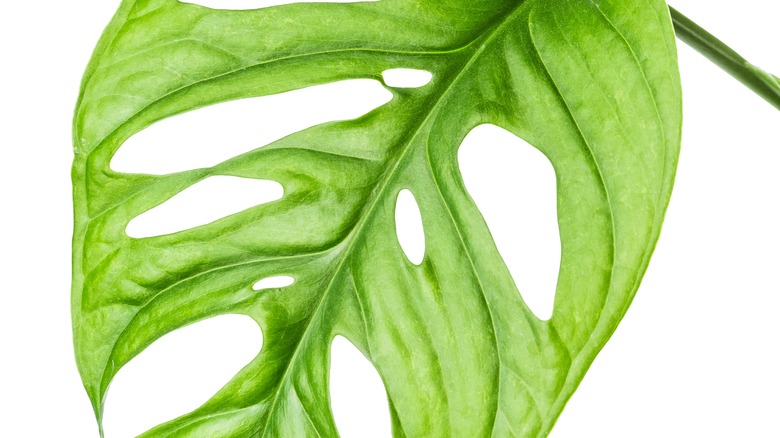How To Grow And Care For A Monkey Mask Plant
Ahh, the monstera! This wildly popular genus of house plants has given us both the monstera deliciosa — a tall, bold-leafed, multi-stemmed philodendron — as well as the monstera adansonii (seen above), which is a low-lying, vining plant. Both monsteras are famous for their quirky leaves with large holes, or fenestrations, which cause them to resemble Swiss cheese. However, while the holes of the deliciosa spread out towards the edges until the leaves crack open, the edges of the adansonii leaves remain closed.
Sometimes nicknamed a Swiss cheese plant just like its cousin deliciosa, the monstera adansonii species is more often referred to as a monkey mask plant. It's pretty fun to imagine a little rainforest capuchin peeking its eyes through one. So, who could blame the person who came up with that fitting nickname? Native to Central and South America, monstera adansonii is a tropical perennial that can grow 60 feet high, according to Plantly. That's one long vine! In your home, it's more likely to top out at 10 to 13 feet tall, which is still significant. Similar to the long legs of a pothos, the vines of this plant can be easily trained to grow along stakes and poles.
How to grow a monkey mask plant
Think of the massive, woody vines cascading throughout a tropical rainforest, reaching towards the sky as they twist around whatever host tree they can stretch themselves to. Monstera adansonii plants grow just like those liana vines, which secure themselves via aerial roots to tree trunks or rocks at ground level, then climb for as long and high as they can. Of course, they will use any structure available for support, but the best way to set your indoor monkey mask up for this kind of growth success is to establish it on a moss pole. A moss pole will provide them with moisture and the texture of the outdoors.
Moss poles are simple to make and can be built by hand with a few supplies. The Healthy Houseplant advises using a stake, twine, and sphagnum or sheet moss softened by soaking in water for 20 minutes. Then, starting a few inches from the bottom of the stake, wrap your moss around the pole, securing it with the twine as you work your way up. Keep at it until the pole is completely covered with 1 inch of moss, and save for that bottom section which you will insert into the planter. To propagate new plants from a healthy adult, cut a few vines and place them in water that you will need to refresh every few days. Once new roots have grown a few inches, transfer your cuttings to individual pots with soil.
How to care for a monkey mask plant
Your monstera adansonii loves moisture. In fact, all plants in the monstera family hail from hot, humid climates, meaning they prefer at least 50% humidity, per Epic Gardening, so if you live in a dry area, consider adding a humidifier to the room. In a pinch, a tray of water nearby can add moisture to the air as it evaporates. If you have a sunlit bathroom, you could also train your vine around a bathtub where it will regularly receive added humidity from showers.
For an opposite effect from a climbing vine, a monkey mask will do well as a hanging plant too. Secure the basket in a high spot, and the vines will pour gently over the sides and right down to the floor. In either case, don't go overboard with the water. Moisture is key to a healthy adansonii, but too much water will inevitably lead to root rot. Instead, allow the soil of your plant to dry out between waterings, and you should be all set. Another important aspect of monkey mask care is temperature. These plants cannot handle anything below 55°F. Nor will they tolerate cold drafts in the winter. That could make it a little tricky as you're searching for a well-lit area in your home that is also not too close to a window sill.
Monkey mask plant varieties
There is a rare variegated monstera adansonii monkey mask plant, and it is absolutely divine! The leaves of this plant look like individually painted watercolor masterpieces. Be warned: They are difficult to find and incredibly expensive once you've tracked one down. They are also harder to grow. Bloom Sprouts explains that a mutation in the plant's chlorophyll formation is responsible for the marbled effect. Having less chlorophyll means slower overall growth, and it will require more light to thrive. If you are lucky enough to own one of these beauties, adding grow lights during winter can be beneficial. And never leave it sitting in the dark.
As noted by The Potted Pixie, other varieties of monkey mask plants include:
- Monstera adansonii laniata — This variety is very similar to the original, this variety has a deeper green hue, and its leaves are shiny.
- Monstera adansonii archipelago — This is another rare variegated type with much more variegation. On these plants, up to half of each leaf and stem can be completely white. It is even more delicate and difficult to maintain because it contains such an extremely low level of chlorophyll.
- Monstera acuminata — This variety is not so common. Its leaf form fades to a point, shrinking towards the stem, and it has fewer holes than the original monstera adansonii.
- Monstera lechleriana — This plant has substantially larger leaves than most adansonii and can develop to be much larger if given enough space and humidity.
Is the monkey mask plant toxic?
Unfortunately, monkey mask plants contain a potent irritant in the form of calcium oxalate crystals; therefore, the leaves are toxic when ingested by both pets and humans. However, the risk assessment is relatively low, with irritation generally restrained to a temporary mild burning sensation with some swelling. Symptoms typically wear off within 24 hours. Also, the discomfort hits so fast on the tongue and lips that anyone munching on a leaf is likely to decide against continuing quite quickly.
Of course, we've all heard stories or lived through experiences of a clueless cat or dog who just doesn't know when to leave well enough alone. So, if the occasion strikes and your pet continues to ingest the calcium oxalate crystals, it's important to seek veterinary care as soon as possible. ASPCA Animal Poison Control Center in Urbana, IL, explains that the needlelike crystals actually become embedded in the flesh of a pet's mouth. The experts recommend using milk or water as rinsing aid.
How to repot a monkey mask plant
Occasionally check drainage holes for roots that are busting through because a root-bound plant will soon become unhappy unless it gets a housing upgrade. Your monkey mask will offer you a few more clues, so keep an eye out for two other symptoms in order to know when it's time to repot. First, yellowing or browning leaves that fall to the ground clearly signify that roots are damaged. Second, dry, cracked soil that no longer retains moisture tells you the ground has become depleted of nutrients.
General repotting will be easy in the beginning, but don't forget that your vine has the potential to keep on spreading. Because they grow so big and long, at some point, repotting will become a project, especially if your monkey mask has twisted its way through a room. Christine Kobzeff lays out an excellent repotting tutorial via her Plant Therapy Thursday series on YouTube. She recommends a soil mix that contains sphagnum peat moss, organic material, perlite, and fertilizer for these rainforest plants. To this, she adds cocoa chips and pumice for aeration and drainage.
Grasp the bottom of the stake and slowly remove the rootball from the pot. Loosen some of the soil away from the roots and move your plant to the larger pot. When you are pushing the stake down into the new soil, be sure to move the roots out of the way to keep them safe.
Monstera adansonii fenestrations
In botany, fenestration is defined as having small perforations or transparent areas. However, per The Sill, there is an ongoing debate over why exactly fenestration occurs. Some scientists believe the holes help wind pass through, making it easier for the plant to survive a hurricane, while others think the holes aid in water flow from the leaves down to the roots. Botanist Christopher Muir is also busy with a theory regarding the vines stretching up towards the canopy high above the rainforest floor in order to obtain even the tiniest specks of sunlight. Is it possible that this striving has caused monsteras to modify the shape of their leaves in the hopes of catching just a little bit more sun?
One thing scientists agree on is that no one yet knows why fenestrations occur in some plants but not in most. For those of you waiting to see the holes in your monstera leaves start to appear, rest assured that the only thing your plant needs is time. You'll start to see fenestrations on the new leaves that sprout after the plant has reached about 3 feet tall. Try cutting back the older leaves to encourage the young ones to grow.
